Trafalgar Square
Trafalgar Square is one of the most well known tourist attractions in the heart of the city. It is quite close to the Charing Cross station and in fact the entire area was earlier known by the name of Charing Cross and fall under the City of Westminster borough. It comprises a number of monuments in the area most of which were built in 1840's the centre piece being the Nelson's Column, which is a 170 feet high column with a statue of the famous general Horatio Nelson at its top. Nelson was the architect of England's famous victory over Napoleon's troops at Trafalgar and hence thename Trafalgar Square in honour of that famous victory. The column has satutes of four lion around it on its base as a sort of guards for it..
The other works of art in the square include many sculptures and statues, ornamental fountains and a special plinth which was orignally left without any statue on it . Only since 1999 this plinth has started displaying works of contemporary art selected by the administrators which are allowed to remain for two years. The Trafalgar Square has become a favourite ground for demonstrations by various political outfits and for common gatherings of citizens for celebrating New Year's Eve etc.
Nelson's Column
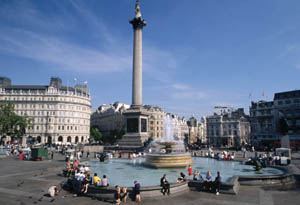
Nelson's Column is in the centre of the square, flanked by fountains designed by Sir Edwin Lutyens in 1937-9 as replacements for two earlier fountains of Peterhead granite (now in Canada), and guarded by four monumental bronze lions sculpted by Sir Edwin Landseer. The column is topped by a statue of Horatio Nelson, the vice admiral who commanded the British Fleet at Trafalgar. The column is 169 feet 5 3/4 inches (51.659 meters) high, and the statue is actually more than triple life-size.
The four bronze lions at the base of the column, by Edwin Landseer, didn't arrive until 1868.
St. Martin-in-the-Fields
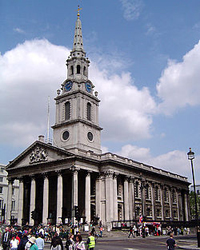
James Gibb's church, St. Martin-in-the-Fields, is in the northeastern corner of Trafalgar Square. There has been a church on this sight since the 13th century; the present building was completed in 1726. Its magnificent Corinthian portico has been much copied in the US where it became a model for the Colonial style of church building.
St. Martin-in-the-Fields is the official parish church for Buckingham Palace. Inside, there is a royal box on the left of the alter and one for the admiralty on the right.
There is a shelter for the homeless and a very good cafe in the crypt, as well as the London Brass Rubbing Centre.
National Gallery
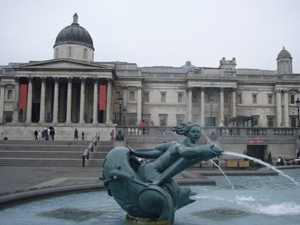
On the north side of the square is the National Gallery and to its east St Martin-in-the-Fields church. The square adjoins The Mall entered through Admiralty Arch to the southwest. To the south is Whitehall, to the east Strand and South Africa House, to the north Charing Cross Road and on the west side Canada House.
The neoclassical National Gallery is not based on a former royal collection, but was begun as late as 1824 when the government agreed to buy 38 paintings belonging to the Russian, John Julius Angerstein.
Canada House
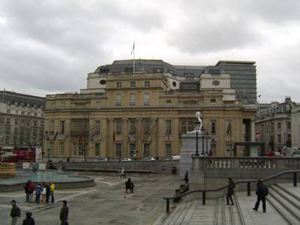
Canada House is on the west side of Trafalgar Square. It is made from warm Bath stone, and was devised by Robert Smirke who also designed the British Museum.Canada House has retained much its original neoclassical interior.
Fourth Plinth
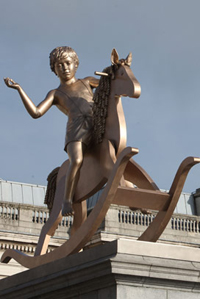
There are 4 plinths installed at the four corners of the square. The Fourth Plinth, built in 1841, was designed to hold a statue of William IV, but remained empty as there were not enough funds till 1999. Now a temperory piece art is installed and changed every two years.
The current bronze sculpture is of a boy astride his rocking horse, celebrating heroism of growing up.
Admiralty Arch
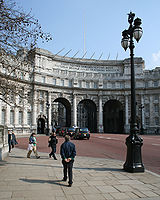
Built in 1911, Admiralty Arch has five arches with Portland stone. Automobiles can pass through two centre aches. The two side arches are for pedestrian traffic. It housed several government offices, but in 2012 the government sold it to a property developer for redevelopment into a luxury hotel.
Admiralty Arch is known to the locals for its "nose" by artist Rick Buckley in 1997, a cemented nose-shap seen on the left of the central arch, about 7 feet (2 meters) from the ground. Some say it is in homage to Edward VII's large nose while some say that it is Napoleon's nose.
National Portrait Gallery
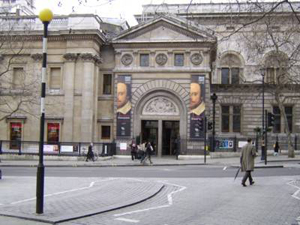
The Gallery was founded in 1856 to collect portraits of famous British men and women. Explore over 175,000 portraits from the 16th Century to the present day.
|



